Melbourne’s getting a new double decker bus.
It’s been on display at a trade show at Jeff’s Shed (that’s the Melbourne Exhibition Centre for those not in the know), and a PTV contact passed these photos on…
Inside, as you’d expect, the low ceiling makes it seem a little more cramped than single deck buses. But from memory of riding them in the UK, this isn’t generally seen as a problem.
Apparently there’s a digital display somewhere downstairs indicating how many seats are available upstairs.
The bus will be run by bus operator CDC, with the PTV branding, in the Werribee/Wyndham Vale area. I’m told by locals that some bus routes regularly get overcrowded around there. While routes in the area are being re-organised in June as part of the Regional Rail Link opening, you can bet there’ll be plenty of passenger demand thanks to the huge urban growth there.
This is good to see. Many cities around the world use them, and some routes (the university shuttles spring to mind) could do with higher-capacity buses.
Sure, they can’t run everywhere — low bridges in some parts of town would limit where they can be used. But existing tourist double deckers run in some parts of Melbourne, so there’s no reason they can’t be used on public routes.
Of course, you’d never want to see service frequencies reduced to counter the capacity boost. And increasing frequencies is obviously the preferable way to relieve crowding, but on frequent routes, bigger buses make sense.
In contrast with the argument against double decker trains, dwell times at stops don’t limit throughput on busy routes, because buses can overtake each other — though they might slow down the travel time.
This is not the first time double decker buses have run in Melbourne. They were common in the 1940s, as a replacement for cable trams in Bourke Street until the electric lines opened in the 1950s. I found this lovely photo of one, below, and it turns out there were others as early as the 1910s.
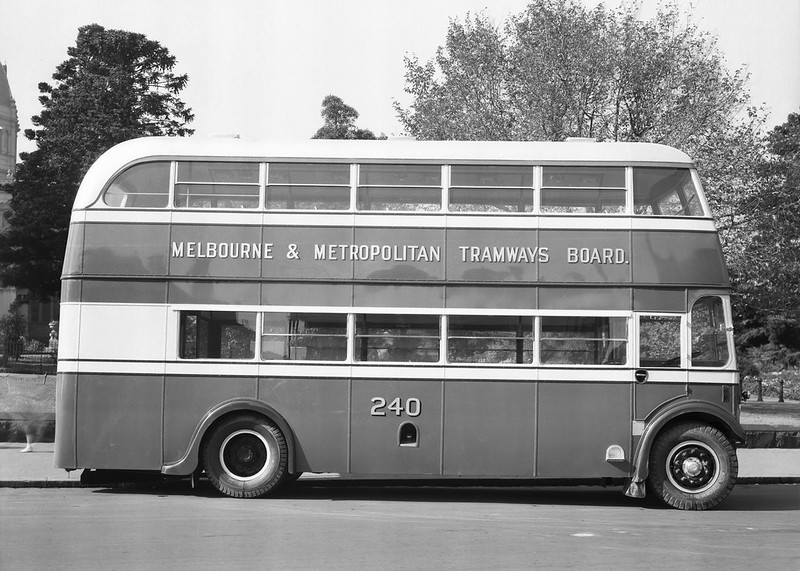
(Source: Lyle Fowler/Harold Paynting Collection, State Library of Victoria. )
The new bus has got some attention. Something a bit different, but more practical than monorails or ferries.
- The Age: Double-decker bus ready to rumble when Regional Rail Link opens
- 3AW: Double-decker buses coming to Melbourne
It’ll be interesting to see it in action, and to see if people like it and the government orders more.
Also notable in buses this week: a bunch more routes now have realtime information available, covering all Smartbuses and (it seems) all Transdev Melbourne routes. This expansion coincided with the launch of PTV’s new realtime API, allowing app developers to use the information to develop their own apps. Neato.
I’m told all buses have the relevant equipment fitted, and more realtime information will rollout pretty quickly to the rest of the suburban bus network. Trams obviously already have Tram Tracker, and trains… well, that’s trickier, they’re still working on it.
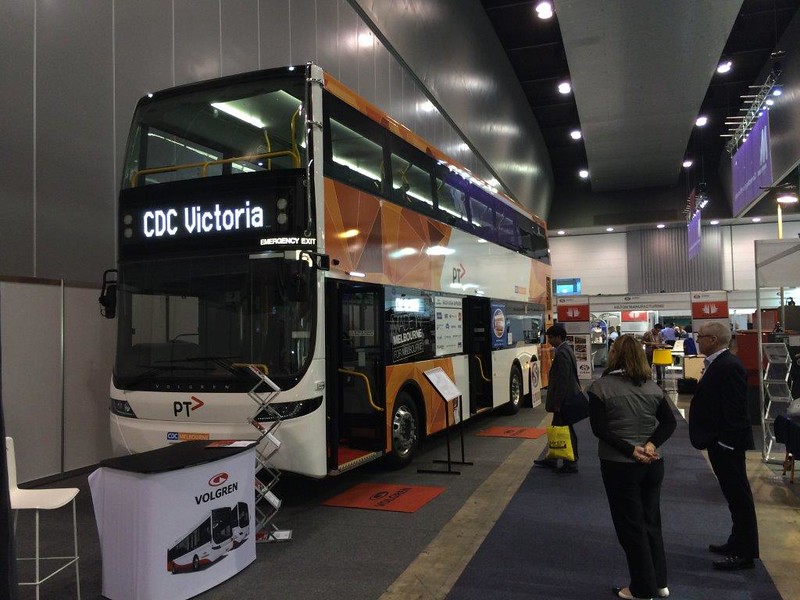
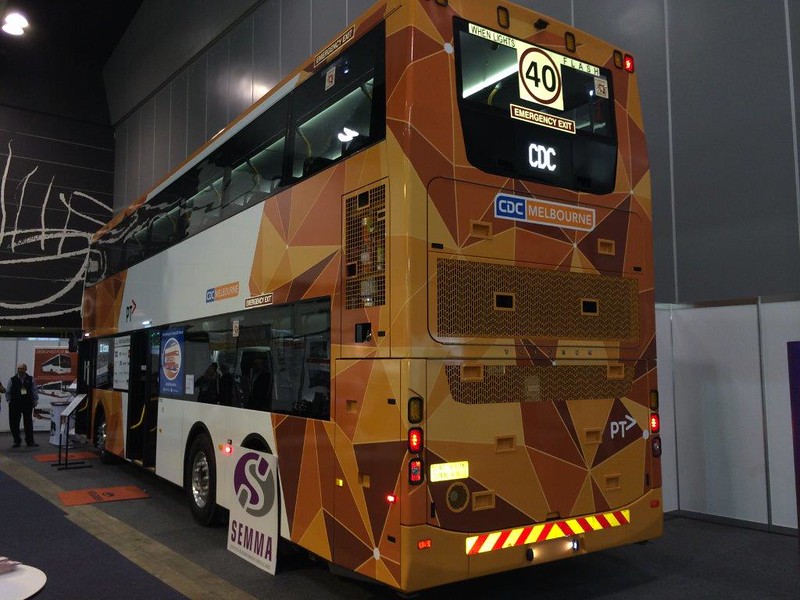
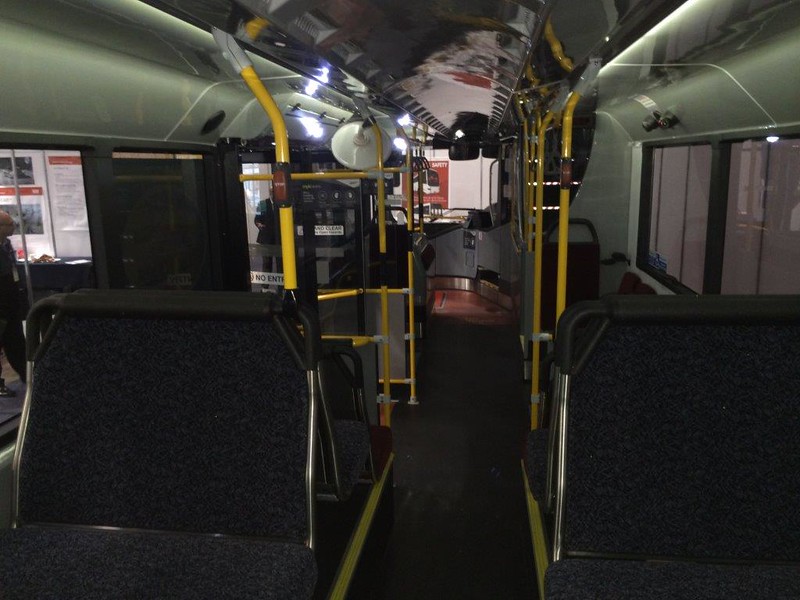
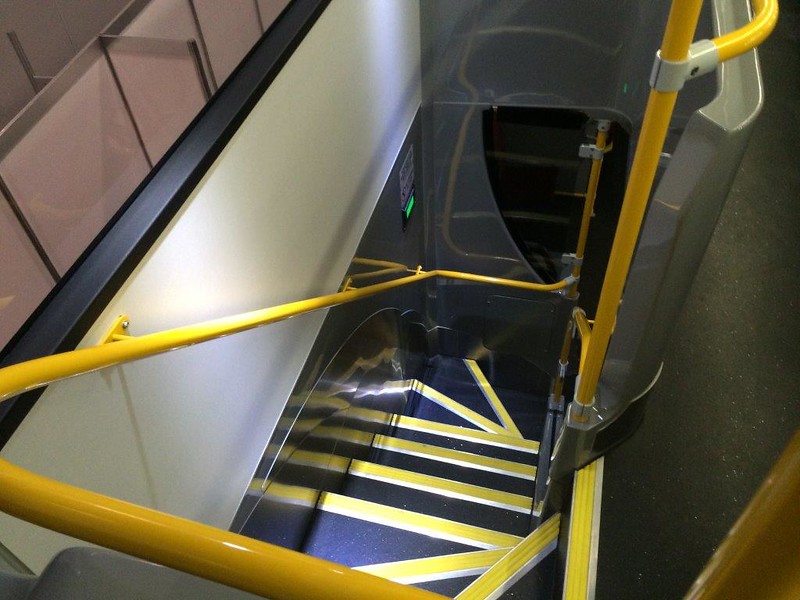
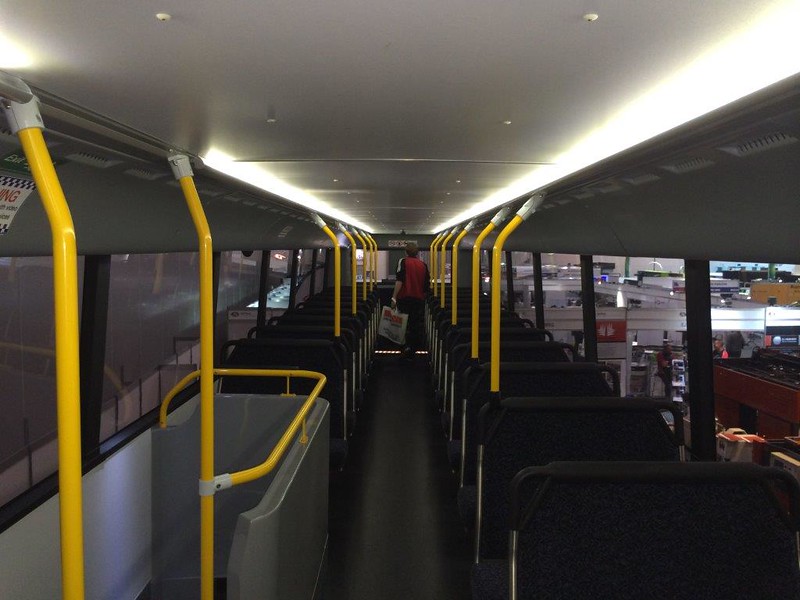
30 replies on “Double decker bus for Melbourne”
“In contrast with the argument against double decker trains, dwell times at stops don’t limit throughput on busy routes”
So was that the reason the sole double decker train (which if I’m correct, only ran on the Lilydale/Belgrave corridor) was decommissioned in 2003? Or was it due to mechanical or other reasons?
While I’m not in a position to say whether it’s scrapping was a good or bad thing overall, I’ve seen pictures of it on Google image searches taken during it’s 1992-2003 running, and thought it’d be awesome to ride on the top deck!
Thanks for your post – I hope that able-bodied people use upstairs since those with disability will have a devil of a job getting up the stairs.
I like the idea, but it would be a shame if (as is likely) double-deckers are used to cater for passenger numbers without increasing service frequency.
Double Decker buses are most useful on longer routes with lost of long trips by passengers so that a greater proportion of passengers have the motivation to clime the stairs.
Do we know why double-decker buses were chosen over bendy-buses?
I find the “Made in Melbourne for Melbourne” part quite ironic. When this bus was built last year, it was delivered from the Dandenong factory in Transport for NSW livery with Hillsbus branding, but after they weren’t able to get it registered in NSW due to it being too heavy for their roads, CDC have decided to send it down south to their Melbourne operation as it just meets Vicroads standards.
So you can’t really say it was “made for Melbourne”.
@Lucas, the fact that the 4D broke down so often probably helped contribute to its demise, but I suspect it was the thinking about dwell times (and the need to modify numerous road over rail bridges to accommodate more DD trains) that killed the idea. I’ve also heard concerns about level crossings given the impact of a motor vehicle with the lower deck should an accident occur, but I don’t know if officialdom rated that as a big concern.
@Tom, as I understand it, there are concerns about bendy buses with existing bus stops, many of which may not strictly cope with longer vehicles, at least where they are of a bay design, or intended to provide pavement to roughly align with where the doors would be. Bendy buses also have difficulties on some roads with sharp corners/turns, including roundabouts.
@L2, I suspect it was CDC and PTV being opportunistic. It would explain the “40” marking on the back, which as far as I recall is universal on Sydney buses, but not normally seen here.
How heavy is it? I thought NSW and Victoria both allowed 20.5 tonnes for three-axle buses with a single-tyre lazy axle.
This is very interesting news. First I knew about it. Am still waiting for Skybus to get their double deckers too.
Doulbe deck v articluated debate I guess the following would be true;
+ Double deck would be double the capacity, whereas an articulated bus would be less than double?
+ As stated above, you need a route with some very long journies being made to make much use of the upper deck, because people who travel only a few stops shall not be going up there.
so to conclude, I would say articluated buses would still be the one of choice for short routes, and those routes which encounter low over-road structures too.
There’s already three bus operators in Melbourne that use bendy buses (Transdev, Ventura Dandenong & Sunbury Bus Service), though some of the routes they’re used on are of pretty dubious need for high capacity vehicles.
Particularly the Sunbury ones seem to spend a lot of time cruising around back streets with about 3 people onboard.
The Age article suggests that the factory in Dandenong exports buses to Singapore, Hong Kong, and Japan.
Amazing if true. While Victoria will no longer be exporting cars, our forte perhaps lies in exporting trams, buses, trains, and aircraft parts.
As Daniel said, the key benefit of double deck buses is that they can normally use existing bus stops – whereas articulated buses often need the bus stops to be extended or changed. I’m told the whole of life cost is also lower than articulated buses (as the bendy bit is more expensive to maintain). Interestingly, the cost of the double deck bus is higher than a standard bus, but not massively. So there is real opportunity to use these types of vehicles selectively to increase capacity.
The 4D train trial was a success – as it showed why double deck trains were a bad idea! Always good to get a clear result from a trial! Put simply, the increased dwell time meant that double deck trains delivered a lower line capacity than single deck trains (and remember, the objective is to increase the capacity of a line, rather than an individual train).
If we look forward ten years, I think that we can expect to see a lot more route specific deployment of buses, featuring a combination of standard, articulated, double deck and mini buses. Matching the type of vehicle to the patronage and infrastructure of the route will be really important.
I think that one of the reasons that PTV has been hesitant about different types of buses is that they wanted to flexibility to changes the routes (eg. if the route structure needs to be overhauled, then keeping a ‘common’ fleet has benefits as it removes an extra area of complexity to be considered).
I’m really looking forward to this trial – and I think a lot will be learned (including the behind the scenes stuff like how does a bus company maintain them, train their drivers, have the vehicles accredited, etc.). I’m really interested in boarding and alighting times (eg. do people come downstairs prior to their stop, etc). Also interested in the use of a single staircase – as many other double deck buses have dual stairs.
It’s really important to have trials like this to see what happens. :)
I may have gotten it wrong – I’ve been told it has two sets of stairs – anyone seen it in person who can confirm? :)
Adrian W, I haven’t seen it in person, but close inspection of the photos that Daniel’s posted all but convinces me that there is only one set of stairs. (There are two doors, with steps(?) up from them to the bottom deck—is that what your informant was referring to?)
Studying the photos, the stairs are just behind the driver, and a person climbing the stairs is facing the front of the bus. The right-hand side of the bus is next to a wall (see external shots). The last photograph is clearly taken from the very front of the top deck (count the windows), and there is clearly no other stair well in sight, with the slight possibility that there is a second one of a different arrangement partly hidden by the person in the photograph. That is, I can’t conclusively rule out that there aren’t stairs going /across/ the bus at the rear (i.e. a person on the stairs would be facing the /side/ of the bus). But there’s certainly not a second stairwell like the one visible.
The reason a double decker may be a good idea is because of a large amount of passengers transferring from Geelong RRL services to buses to Werribee. They likely won’t be disembarking at stops in-between, but closer to the Werribee CBD at the end of the route.
However, there are some highly-patronised routes that would be better off with articulated buses thatn double deckers. Take the 200/207 for example. They run every 7.5 minutes in peak and 10 minutes off-peak, one of the most frequent buses in Melbourne, yet that still doesn’t prevent consistent overcrowding. Large numbers of people get on and off and various points along the route, including Doncaster SC, Willsmere, Kew Junction, Xavier College, Abbotsford Convent, Victoria Park/Hoddle St, Melbourne University and Melbourne Central. If people had to constantly push past each other to get up and down stairs and out the door, running times would crumble.
Longer, articulated buses would make much more sense, just like longer trams with more doors make more sense on busy routes. However, I can see double deckers being useful on perhaps the DART routes, where patronage is fairly city-focussed and there is a long stretch down the freeway with no boarding.
I hope there’s closed circuit TV so the driver can keep an eye on what’s going on upstairs. What wouldn’t have been a problem with the commuters from “nice” North Shore suburbs could be a very different thing in Melbourne’s west at night. Of course, if this is just for peak services to meet the Geelong train I guess it’s not a problem.
Another thought: on longer journeys, the upper level could be a “quiet zone” with no phone calls or headphones permitted.
And I agree that this orange PTV colour scheme is ugly. It looks like a giant Sunny Boy (that dates me). We can see it’s a bus, and not a train or a tram; it doesn’t need to be colour coded. If the livery of all modes was less blah the vehicles might be less vandalised (“broken window theory”).
Yeah the pics look to me like there’s only one staircase, but two doors.
@Francis E, apparently there are 12 CCTV cameras.
So wonder if it will have bike carrying facilities like buses in Canberra. Ha Ha sorry that kind of thing doesn’t happen in Victoria does it.
How about trialling a double decker tram too?
“The 4D train trial was a success – as it showed why double deck trains were a bad idea! Always good to get a clear result from a trial! Put simply, the increased dwell time meant that double deck trains delivered a lower line capacity than single deck trains ”
Any actual evidence for this claim, Adrian W ?
I wasn’t aware of any Melbourne line or station platform 15 or 20 years ago, attempting to run at a frequency where this (alleged) issue with double deck trains could actually be put to the test ( 120 or 130 or 140 seconds between trains ).
@James A
I would recommended people read about Londons experience with articulated buses online. In London the original double-decker buses began to be phased them out in early 2002 and was withdrawn from regular service in December 2005 replaced with articulated buses. But they were unpopular with the public and and not as iconic or as fondly remembered as the old buses. Boris Johnston unveiled the new Routemaster design in 2010 and the ‘bendy’ buses are discontinued and replaced with these.
If you look at the photograph of the old and new designs they are similar in some respects. The color and hop-on hop-off platform etc
https://upload.wikimedia.org/wikipedia/commons/6/62/The_new_Routemaster_%28London_Transport_Museum%29.jpg
With double-decker buses designed in Melbourne they do not resemble the old style double-decker buses as depicted in the photograph above in the article..
Being cynical is the timing of this double-decker bus announcement and Its route in Werribee supposed to be a small consultation. Considering the loss of a direct connection between Geelong and Werribee the new regional rail link. The existing connection will be absent increasing commuter’s travel times shuttling between Wyndham Vale and Werribee stations.
They will need to have someone upstairs all the time or it will get trashed. Got a normal bus yesterday that smelled like the floor of a pub. Boubon and coke all over the floor, rolling bottles.
Does anyone have any idea of when Google maps will get transit info
Back to the question of double decker train, yes there was a lot of research done into the double deck train in Melbourne. Obviously you don’t spend millions of dollars into putting a test train onto the network without seeing what happens! :)
From memory, there were a number of conclusions that ruled out the further deployment of double decker trains on the Melbourne network (which is why subsequent trains have been single deck). When the double deck train was deployed it was assumed by everyone that it was the way of the future….which is why the evidence collected by the trial was so interesting and changed a lot of minds. There was considerable work done to implement the double decker train (including platform changes, some tracks being lowered, etc.). So a lot of people really wanted it to work.
The main issue was in relation to boarding and alighting times. The double deck train just couldn’t keep to the timetable – it was considerably slower than other trains. Initially this was put down to the fact that it was coupled with a three carriage Comeng and that people would run down the platform to get in the ‘new’ carriages, but after the train had been in service for a while this was discounted through research. The train ran so late that it was eventually scheduled in the counter peak so it wouldn’t interfere with other trains.
So I think that the 4D trial was really important. It demonstrated that the longer dwell times reduced the capacity of the line to a point where it didn’t increase line capacity.
So where to from here?
With the knowledge that double deck trains don’t effectively increase line capacity we are now seeing commitments to next generation signalling so that trains can run closer together and plans to lengthen platforms to allow for longer train operation on some lines.
Perhaps another legacy of the 4D is that it started people thinking that perhaps not every type of rolling stock should be deployed on every line. With the Cran/Pak project we will see 37 high capacity trains designed specifically for that line. In the years ahead we can expect to see more line specific rolling stock with train lengths varying between lines. A good example to consider is Perth – they run six carriage trains on some lines and four carriages on other (based on infrastructure). We will see that here over time – some lines will be lengthened to nine carriages, others will remain six or seven (based on the length of existing Flagstaff, Melbourne Central and Parliament platforms).
@L2: “they weren’t able to get it registered in NSW due to it being too heavy for their roads”
SIGH! Time to get on my horse again: we should abolish the states. This week, it’s reading about different load limits. Last week I was grappling with how to pay for a bus trip from Ashmore to Tweed Heads South (Gold Coast area: Ashmore to Wharf St using Go Card, Wharf St to Tweed Heads Sth has to be paid for using cash). Last year (?) it was reading about livestock truck limits: 72 in Victoria, 66 in NSW, 72 in Queensland (thankfully, Duncan Gay fixed that one).
The list goes on and on. Let’s have a referendum and bite the bullet. But in the meantime, if Duncan Gay can stop talking about the chattering classes causing more pollution than trucks and fix this weight law, that would be good.
ps. Don’t do U-turns at traffic lights unless there’s a permitted sign, outside Victoria.
AdrianW: “The train ran so late that it was eventually scheduled in the counter peak so it wouldn’t interfere with other trains.”
I’m not aware of any proper studies showing that its timekeeping performance was below par. There may have been, but all I was aware of was ad hoc checks and subjective opinions. But my ignorance of this is not enough for me to claim that you are wrong.
On the other hand, I can claim that you are wrong on the sentence I’ve quoted above. There was never any rescheduling of it to restrict it to the counter peak. What actually happened was that it was scheduled on trips with less patronage, such as counter-peak and off-peak Lilydale and Belgrave trips and peak-period Blackburn trips. And this was done when, and because, it started running by itself (i.e. not attached to a 3-carriage Comeng train), and this was in turn because that was the only way it could be run without a guard.
“With the Cran/Pak project we will see 37 high capacity trains designed specifically for that line.”
Debatable. Sure, they’ve been designed with that line in mind. But they are designed as high-capacity metro-style short-distance trains, for a long-distance line! I would say that they’ve been designed specifically for high capacity, not specifically for that line.
“In the years ahead we can expect to see more line specific rolling stock with train lengths varying between lines.”
Which we’ve had in the past in Melbourne, for what it’s worth. Most platforms were built long enough for 7-carriage Tait and Harris trains, but platforms on some lines were lengthened for 8-carriage Tait and Harris trains. Later, ones that hadn’t been lengthened were lengthened for 6-carriage stainless steel trains. Except for the St. Kilda(?) and Port Melbourne lines which couldn’t take more (if I recall correctly) than 6-carriage Tait trains.
And of course we’ve had plenty of trains of different lengths over the years, with trains of one, two, three, four, six, seven, and eight carriages. (I can’t think of any 5-carriage suburban trains, but there probably were examples.)
Kiwi Nick: “SIGH! Time to get on my horse again: we should abolish the states.”
Err, yes? Why? Because there are some things they differ on? In that case we should abolish countries too! Hey, let’s have a one-world government! Of course, it will probably be dominated by some other part of the world, and we will feel neglected, but at least we won’t have those pesky inconsistencies!
And of course there won’t be the same variety of views, so instead of having one country (or state) being prepared to try something that the rest of the world (or country) isn’t willing to try, something that might actually turn out to be a good idea, let’s just have one decision-making body that only has one idea at a time.
Keep in mind that having one government is the only way to achieve this consistency; we know from experience that it never works to have different states getting together and agreeing on some things, like common designs of speed limit signs (oops, they do agree), common rules about keeping left on roads above 80 kph (oops, they standardised that one), etc. I mean, it’s not as though the different states have adopted any standard Australian rules (https://en.wikipedia.org/wiki/Australian_Road_Rules), is it?
You’re right. Having every part of the country the same is wonderful, even if the cost is innovation, variety, competition, and progress. I can’t wait (to vote “no” at your referendum).
Thank you Daniel for an interesting story. But also for your thoughtful ‘geekiness’ (we are like-minded souls!) in including an excellent photo of one of the 45 Leyland TD5c Titan double-decker buses that operated the M&MTB’s Bourke Street route to Clifton Hill, Northcote, Collingwood, etc from October 1940 to circa 1954, having commenced as replacements for Melbourne’s last cable trams.
I have done a bit of research into those buses, and obtained photos and other relevant material from the archives of the Melbourne Tram Museum in Hawthorn. If you are interested, I will be happy to discuss and share that information with you. Feel free to contact me via my email address.
HAVING a loo will help on the freeway-standstill-?is their a toilet on this one
Spent years of my early childhood riding on MMTB Leyland Double Deckers to Melborne Bourke St from Northcote on, yes, the cable car route which finished on Sept 4 or 5 1939 (when I was rushed from my birth at Epworth Hospital Richmond so I could always say I’d ridden on said cable tram up ‘Ruckers Hill’ Northcote.) Re the bus, either sat on top deck front seat with long suffering Mum or stood down on the brass transmission cover gripping the brass horizontal rail behind the ‘cab’ watching the every move of the poor frustrated driver in his ‘cockpit’. I loved the ‘romance’ of these monster buses which I longed to drive. They terminated past Hoyts Regent Theatre Thornbury where they accomplished a massive U turn to return to the city. On hot days, l enjoyed watching the great tyres squelching the melting bitumin. In time I learnt to drive & fly, but sadly, never to ‘pilot’ my giant beloved green & yellow friends.